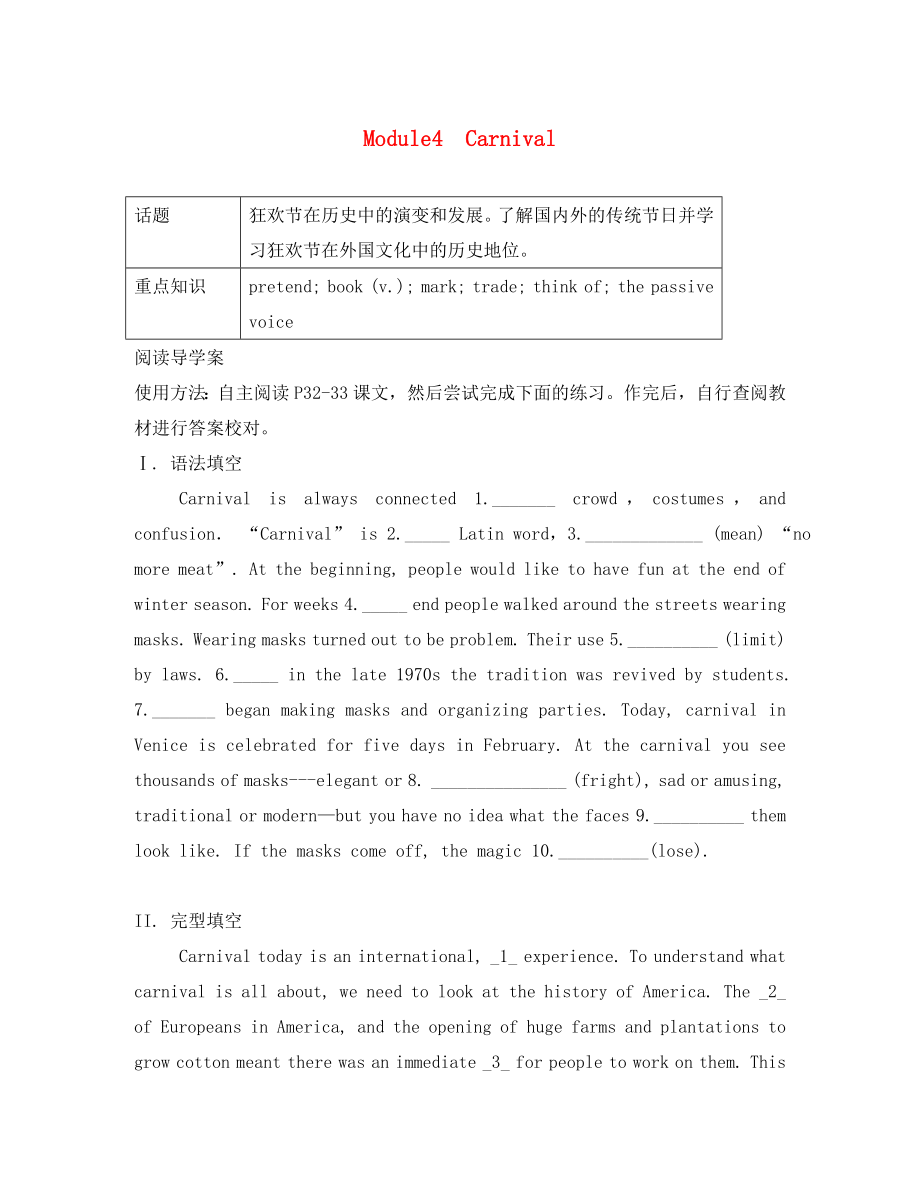《2020屆高三英語一輪復(fù)習(xí) Module 4 Carnival閱讀案(無答案)外研版必修5》由會(huì)員分享���,可在線閱讀���,更多相關(guān)《2020屆高三英語一輪復(fù)習(xí) Module 4 Carnival閱讀案(無答案)外研版必修5(4頁珍藏版)》請?jiān)谘b配圖網(wǎng)上搜索。
1����、Module4 Carnival
話題
狂歡節(jié)在歷史中的演變和發(fā)展���。了解國內(nèi)外的傳統(tǒng)節(jié)日并學(xué)習(xí)狂歡節(jié)在外國文化中的歷史地位。
重點(diǎn)知識
pretend; book (v.); mark; trade; think of; the passive voice
閱讀導(dǎo)學(xué)案
使用方法:自主閱讀P32-33課文���,然后嘗試完成下面的練習(xí)�。作完后���,自行查閱教材進(jìn)行答案校對��。
Ⅰ. 語法填空
Carnival is always connected 1._______ crowd,costumes���,and confusion. “Carnival” is 2._____ Latin wo
2���、rd,3._____________ (mean) “no more meat”. At the beginning, people would like to have fun at the end of winter season. For weeks 4._____ end people walked around the streets wearing masks. Wearing masks turned out to be problem. Their use 5.__________ (limit) by laws. 6._____ in the late 1970s the t
3���、radition was revived by students. 7._______ began making masks and organizing parties. Today, carnival in Venice is celebrated for five days in February. At the carnival you see thousands of masks---elegant or 8. _______________ (fright), sad or amusing, traditional or modern—but you have no idea wh
4���、at the faces 9.__________ them look like. If the masks come off, the magic 10.__________(lose).
II. 完型填空
Carnival today is an international, _1_ experience. To understand what carnival is all about, we need to look at the history of America. The _2_ of Europeans in America, and the opening of hu
5��、ge farms and plantations to grow cotton meant there was an immediate _3_ for people to work on them. This _4_ the beginning of the slave trade. Until the beginning of the 19th century, _5_ the trade was finally stopped, millions of people were taken by _6_ from their homes in Africa to work as slave
6��、s. _7_, the Europeans also imported their own festivals. So the slaves were forced to watch as their masters _8_ carnival with food, drink, and masked dances. Then, the slaves began to hold their own carnival celebrations ���,_9_ their own African traditions — such as walking round a village wearing ma
7、sks and singing. When the slave trade was _10_ in 1838 the former slaves _11_ the carnival. It became more _12_ and more exciting than it had been before. Carnival became a celebration of freedom. _13_ the passing of time, the white inhabitants began to take part in the carnival, too. Carnival becam
8��、e a way to _14_ different communities. Today, carnival has become a celebration of life_15_.
1. A. multimedia B. multicultural C. multitasking D. multiplayer
2. A. arrive B. arrival C. arrived D. arriving
3. A. need B. respect C. explanation D. reason
4. A. signed B. s
9���、ignaled C. marked D. symbolized
5. A. as B. while C. before D. when
6. A. force B. strength C. power D. energy
7. A. Naturally B. Fortunately C. Sadly D. Usually
8. A. congratulated B. compared C. celebrated D. combined
9. A. follow B.
10��、following C. followed D. to follow
10. A. added B. accepted C. admitted D. abolished
11. A. took on B. took up C. took over D. took off
12. A. grateful B. respectful C. stressful D. colorful
13. A. With B. As C. For D. After
14. A. connec
11����、t B. unite C. combine D. link
15. A. it B. it’s C. its D. itself
III. 課文重點(diǎn)句型翻譯:
1.連續(xù)幾個(gè)星期人們戴著面具走在街上�,為所欲為而不會(huì)被認(rèn)出來。
_________________________________________________________________________
_________________________________________________________________________
2. 普通人可以裝成闊
12����、佬和要人,而名人也可以偷偷地體驗(yàn)浪漫奇遇����。
_________________________________________________________________________
3. 很多罪行逃脫了懲罰��。
_________________________________________________________________________
4. 如果他們違犯了法律���,就要被判處長達(dá)兩年的監(jiān)禁。
_________________________________________________________________________
5.人們把狂歡節(jié)看成是在冬季結(jié)束時(shí)可以盡情玩樂的一個(gè)最后機(jī)會(huì)����。
_________________________________________________________________________
6. 面具的使用受到了法律條文的限制,這最早可追溯到14世紀(jì)���。
_________________________________________________________________________
 2020屆高三英語一輪復(fù)習(xí) Module 4 Carnival閱讀案(無答案)外研版必修5
2020屆高三英語一輪復(fù)習(xí) Module 4 Carnival閱讀案(無答案)外研版必修5

